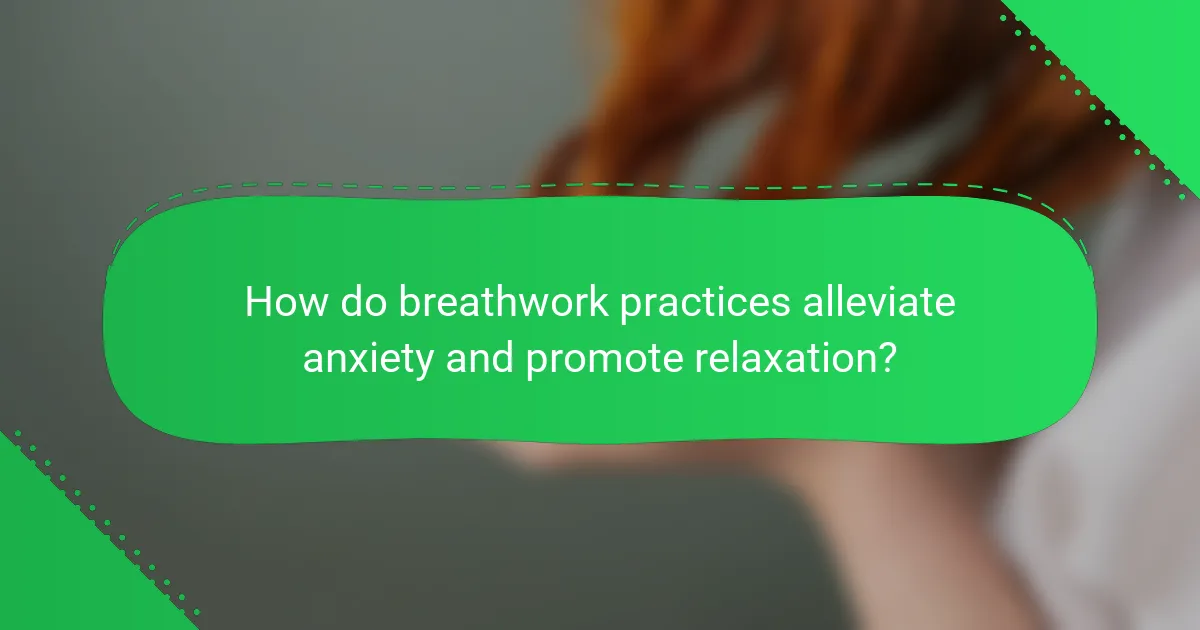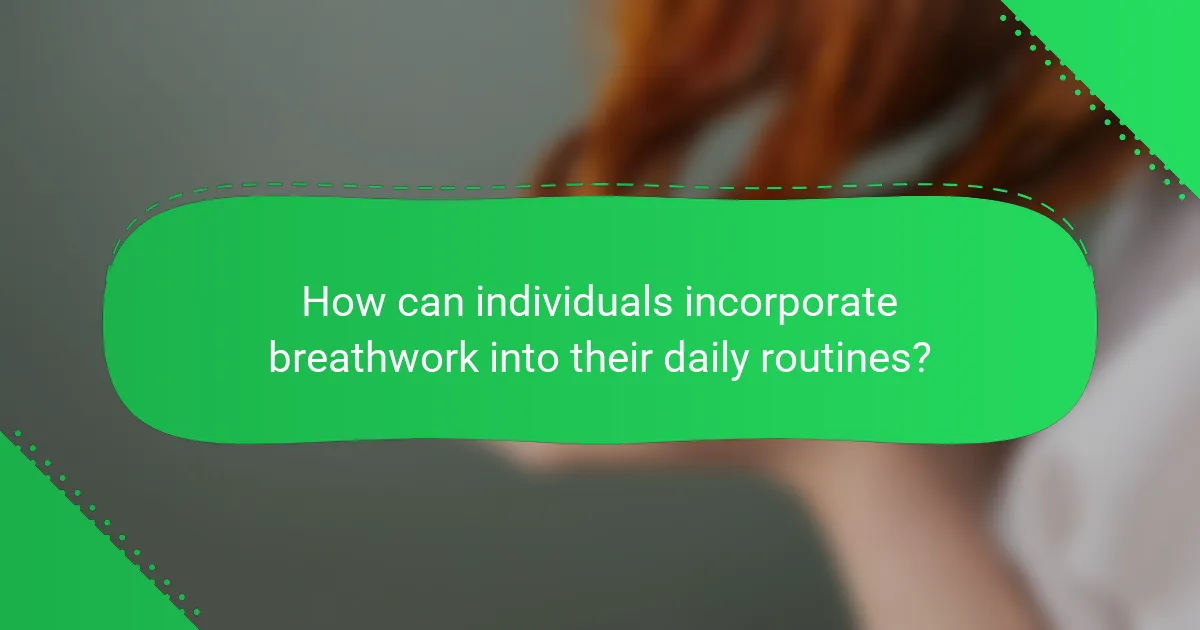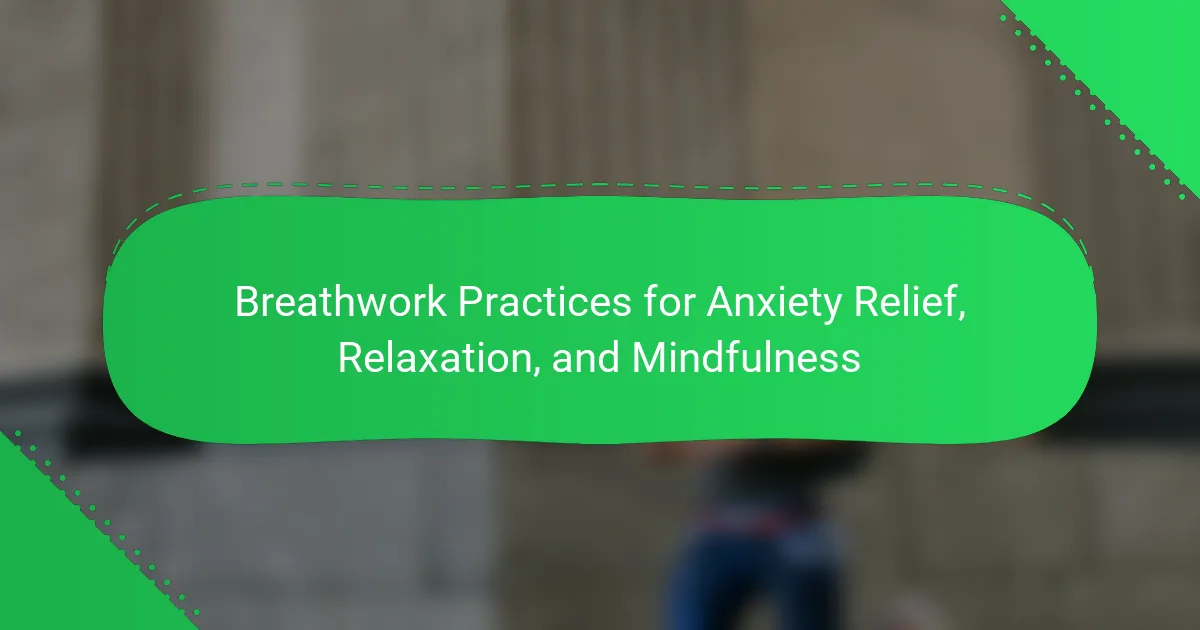Breathwork practices provide effective anxiety relief, enhance relaxation, and promote mindfulness. Techniques like diaphragmatic breathing and box breathing regulate the nervous system and lower cortisol levels. Cultural influences from yoga and Taoism shape modern methods, while emerging trends integrate technology for personalized experiences. Regular practice fosters emotional resilience and self-awareness, making it a valuable tool for mental well-being.

How do breathwork practices alleviate anxiety and promote relaxation?
Breathwork practices effectively alleviate anxiety and promote relaxation by regulating the nervous system and enhancing mindfulness. Techniques such as diaphragmatic breathing and box breathing lower heart rates and reduce cortisol levels. Research indicates these methods can decrease anxiety symptoms by up to 50%. Additionally, breathwork fosters a greater sense of presence, allowing individuals to engage with their thoughts and feelings without judgment. This practice also cultivates emotional resilience, enabling better stress management over time.
What physiological changes occur during breathwork sessions?
Breathwork sessions induce several physiological changes that enhance relaxation and mindfulness. These include reduced heart rate, lowered blood pressure, and increased oxygenation of the blood. As a result, the body shifts from a state of stress to one of calmness. Additionally, breathwork can stimulate the vagus nerve, promoting a sense of well-being. This practice also influences the autonomic nervous system, fostering a balance between the sympathetic and parasympathetic responses.
Which breathing techniques are most effective for anxiety relief?
Breathwork techniques such as diaphragmatic breathing, box breathing, and 4-7-8 breathing are most effective for anxiety relief. These methods promote relaxation, reduce stress, and enhance mindfulness.
Diaphragmatic breathing involves deep inhalation through the nose, filling the abdomen, followed by a slow exhalation. This technique lowers heart rate and calms the nervous system.
Box breathing consists of inhaling for four counts, holding for four counts, exhaling for four counts, and holding again for four counts. This structured approach helps regain focus and control during anxiety episodes.
4-7-8 breathing entails inhaling for four counts, holding for seven counts, and exhaling for eight counts. This method can significantly reduce anxiety and promote better sleep by activating the body’s relaxation response.
How does breathwork enhance mindfulness and self-awareness?
Breathwork enhances mindfulness and self-awareness by promoting relaxation and focus. Through intentional breathing techniques, individuals can quiet their minds, reducing anxiety and increasing present-moment awareness. This practice encourages deeper emotional exploration, fostering self-reflection and clarity. Research indicates that breathwork can lower cortisol levels, enhancing overall mental well-being. Regular engagement in breathwork cultivates a heightened sense of self-awareness, allowing individuals to recognize and respond to their thoughts and feelings more effectively.

What are the psychological benefits of regular breathwork practice?
Regular breathwork practice offers significant psychological benefits, including anxiety relief, enhanced relaxation, and improved mindfulness. These practices activate the parasympathetic nervous system, leading to reduced stress levels.
Research shows that breathwork can lower cortisol levels, which are linked to stress. Additionally, participants report increased emotional regulation and resilience, contributing to overall mental well-being. Regular sessions can also enhance self-awareness, allowing individuals to connect more deeply with their thoughts and emotions.
In summary, the psychological benefits of breathwork include stress reduction, improved emotional control, and heightened mindfulness.
How does breathwork impact stress levels and emotional regulation?
Breathwork significantly reduces stress levels and enhances emotional regulation. Techniques like deep diaphragmatic breathing activate the parasympathetic nervous system, promoting relaxation. Studies show that consistent breathwork practice can lower cortisol levels, improving overall emotional resilience. For instance, participants in breathwork sessions reported a 40% decrease in anxiety symptoms after eight weeks of practice. This method encourages mindfulness, helping individuals manage their emotions more effectively.
What role does breathwork play in improving mental clarity and focus?
Breathwork significantly enhances mental clarity and focus by promoting relaxation and reducing stress. Techniques such as deep breathing and rhythmic inhalation help calm the mind, increasing cognitive function. As a result, regular practice can lead to improved concentration and decision-making abilities. Breathwork also supports mindfulness, allowing individuals to stay present, which further sharpens focus.

Which cultural traditions influence modern breathwork practices?
Cultural traditions such as yoga, Taoism, and indigenous practices significantly influence modern breathwork. These traditions emphasize the connection between breath, body, and mind, promoting relaxation and mindfulness. Yoga integrates breath control (pranayama) to enhance physical and mental well-being. Taoist practices focus on harmonizing energy through breath, fostering inner peace. Indigenous cultures often incorporate breathwork in spiritual rituals, emphasizing its role in healing and connection to nature. Together, these influences shape contemporary breathwork techniques used for anxiety relief and personal growth.
How do Eastern philosophies shape breathwork techniques?
Eastern philosophies significantly influence breathwork techniques by emphasizing mindfulness and the connection between breath and mental states. Practices such as yoga and meditation incorporate breath awareness to promote relaxation and reduce anxiety. Techniques like Pranayama from yoga focus on controlled breathing to enhance energy flow and mental clarity. This integration encourages practitioners to cultivate a deeper awareness of their breath, leading to improved emotional regulation and stress relief. The unique attribute of Eastern breathwork lies in its holistic approach, combining physical, mental, and spiritual aspects for comprehensive well-being.
What are the unique attributes of breathwork in Western wellness communities?
Breathwork in Western wellness communities uniquely emphasizes emotional release, community connection, and diverse techniques. These practices often incorporate various breathing patterns to promote anxiety relief, relaxation, and mindfulness.
A unique attribute of breathwork is its adaptability, allowing individuals to tailor sessions to personal needs and experiences. For instance, some techniques focus on rapid, energizing breaths, while others utilize slow, calming patterns.
Additionally, breathwork fosters a sense of community through group sessions, enhancing shared experiences and collective healing. This communal aspect differentiates it from solitary practices like meditation.
Finally, breathwork is increasingly supported by scientific research, validating its benefits for mental health and overall well-being. Studies indicate that breathwork can significantly reduce stress and improve emotional regulation.

How can individuals incorporate breathwork into their daily routines?
Individuals can incorporate breathwork into their daily routines by setting aside dedicated time for practice. Start with five minutes each morning or evening to focus on deep, intentional breathing.
1. Choose a quiet space free from distractions.
2. Sit comfortably or lie down, ensuring your posture is relaxed.
3. Inhale deeply through your nose for a count of four.
4. Hold your breath for a count of four.
5. Exhale slowly through your mouth for a count of six.
6. Repeat this cycle for several minutes, gradually increasing the duration.
As a result, this practice can enhance relaxation, reduce anxiety, and promote mindfulness throughout the day. Consistency is key; aim to practice daily for maximum benefits.
What are the best practices for beginners in breathwork?
To effectively engage in breathwork for anxiety relief, beginners should focus on a few key practices. Start with diaphragmatic breathing, which encourages deeper inhalation and exhalation, promoting relaxation. Incorporate box breathing, where you inhale for four counts, hold for four, exhale for four, and hold again for four, to help regulate stress levels. Practicing mindfulness during breathwork enhances awareness and presence, reducing anxiety. Regular practice, even for short sessions, builds familiarity and comfort with techniques. Finally, create a calming environment to support relaxation and focus during sessions.
Which common mistakes should be avoided when practicing breathwork?
To practice breathwork effectively, avoid common mistakes such as shallow breathing, neglecting proper posture, and rushing through techniques. Focus on deep, diaphragmatic breaths, maintain an aligned body, and take your time to cultivate mindfulness. Additionally, avoid distractions and set a calming environment to enhance your experience. These adjustments can significantly improve anxiety relief and relaxation outcomes.

What unique breathwork methods are emerging in 2025?
Emerging breathwork methods in 2025 include techniques that enhance anxiety relief, relaxation, and mindfulness. These practices focus on integrating technology, such as biofeedback devices, to optimize breathing patterns. Another trend is the incorporation of sound therapy, using specific frequencies to deepen relaxation and enhance emotional release. Group sessions are evolving, utilizing virtual reality to create immersive environments that promote collective mindfulness experiences. Additionally, personalized breathwork plans, tailored to individual stress responses, are gaining popularity, emphasizing unique attributes of each practitioner.
How are technology and apps enhancing breathwork experiences?
Technology and apps significantly enhance breathwork experiences by providing guided sessions, tracking progress, and creating personalized routines. These tools improve accessibility and engagement, making breathwork more effective for anxiety relief, relaxation, and mindfulness.
Mobile applications offer features like real-time feedback, reminders, and community support, fostering a consistent practice. For instance, some apps utilize biofeedback to optimize breathing techniques based on user data, enhancing the overall experience.
Moreover, virtual reality technology can immerse users in calming environments, further promoting relaxation during breathwork sessions. This integration of technology not only enriches the practice but also encourages users to explore various techniques tailored to their individual needs.
Which innovative approaches to breathwork are gaining popularity?
Innovative approaches to breathwork gaining popularity include techniques like Holotropic Breathwork, Transformational Breath, and Wim Hof Method. These practices emphasize emotional release, self-discovery, and enhanced physical performance. Holotropic Breathwork combines accelerated breathing with music for deep emotional exploration. Transformational Breath integrates sound and movement, promoting relaxation and mindfulness. The Wim Hof Method combines breath control, cold exposure, and meditation to boost resilience and well-being. Each method uniquely addresses anxiety relief and mindfulness, attracting diverse practitioners.

What are the rare yet impactful benefits of breathwork for specific populations?
Breathwork offers rare yet impactful benefits for specific populations, such as individuals with PTSD, chronic pain, and high-stress professions. For PTSD sufferers, breathwork can significantly reduce anxiety and promote emotional regulation. Chronic pain patients may experience enhanced pain management through controlled breathing techniques. High-stress professionals often find breathwork aids in improving focus and reducing burnout. These practices foster relaxation and mindfulness, enhancing overall well-being.
How can breathwork support individuals with chronic health conditions?
Breathwork can significantly support individuals with chronic health conditions by promoting relaxation and reducing anxiety. These practices enhance mindfulness, leading to improved emotional regulation and stress management.
Research shows that breathwork can lower cortisol levels, which are often elevated in chronic conditions. Techniques such as diaphragmatic breathing and box breathing can improve oxygen flow, enhancing overall well-being. Regular practice fosters a sense of control over one’s body and mind, which is crucial for managing chronic health issues.
Incorporating breathwork into daily routines can lead to better sleep quality, increased energy levels, and reduced symptoms of anxiety and depression. These benefits contribute to a more holistic approach to health management, empowering individuals to take charge of their wellness journey.
What unique adaptations of breathwork are beneficial for athletes?
Unique adaptations of breathwork for athletes enhance performance and recovery. Techniques like diaphragmatic breathing improve oxygen efficiency, while box breathing aids focus and reduces anxiety. Specific practices such as the Buteyko method can optimize breathing patterns during high-intensity training. Athletes also benefit from pranayama, which promotes relaxation and mindfulness, leading to better mental clarity and reduced stress. These adaptations support both physical and mental aspects of athletic performance.
What expert tips can enhance the effectiveness of breathwork practices?
To enhance the effectiveness of breathwork practices, focus on consistency, technique, and environment. Regular practice builds familiarity and deepens relaxation. Use techniques like diaphragmatic breathing to maximize oxygen intake. Creating a calm environment reduces distractions, allowing for deeper mindfulness. Incorporating guided sessions can also provide structure and support.
